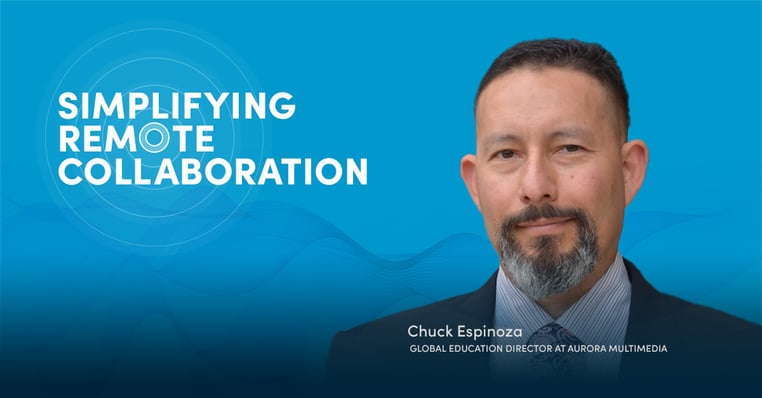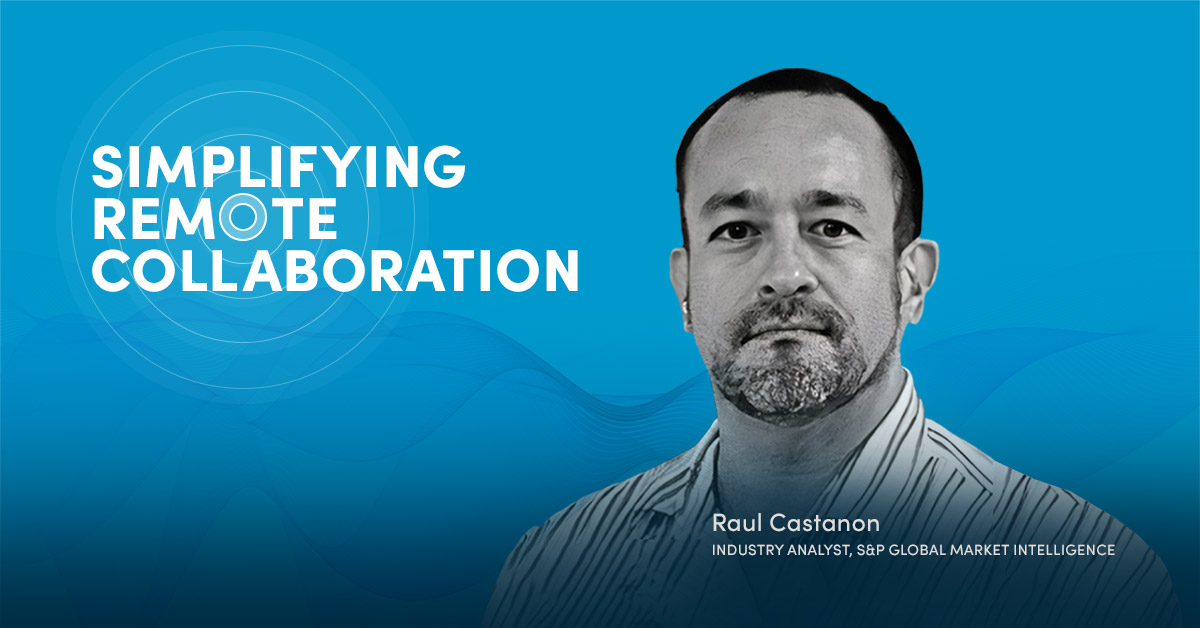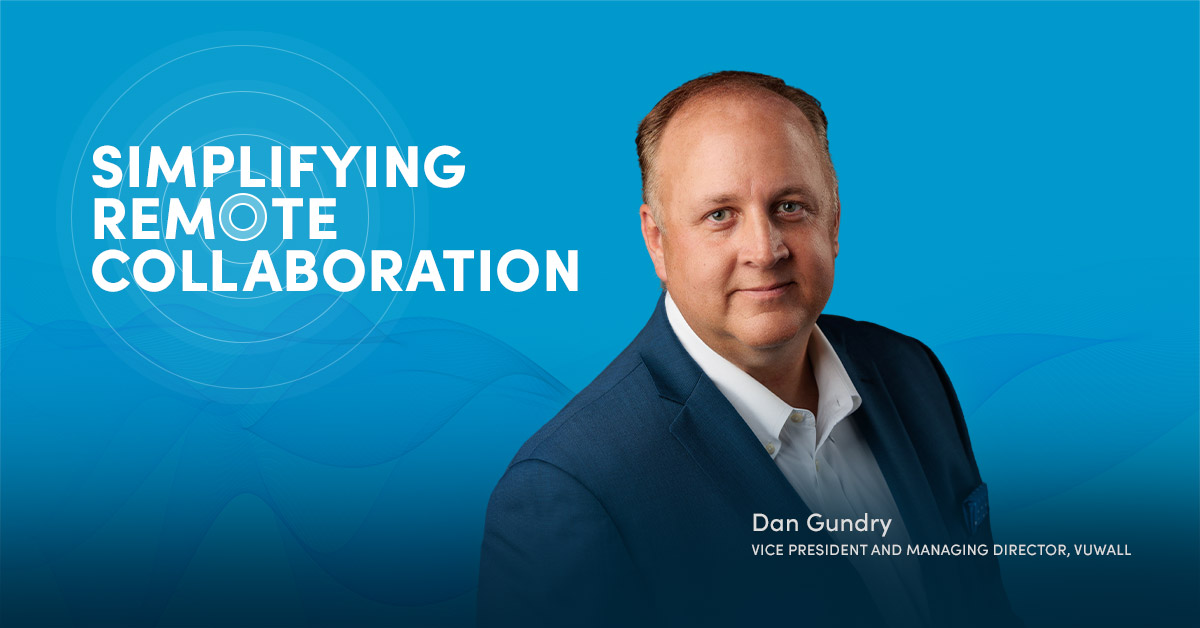June 13, 2023
Video podcast: AV retrofitting – know your users (and your cables)

Posted by Dave McKean on Jun 13, 2023 6:00:00 AM
The COVID-19 pandemic and the rise of hybrid work and HyFlex learning have fundamentally changed what it means to work in IT. In this episode of the Simplifying Remote Collaboration podcast, Ben Thomas talks to Chuck Espinoza, global education director at Aurora Multimedia. Chuck has tips on retrofitting rooms for new AV setups, and he tells us the importance of understanding and centering user needs in all AV projects.
Timestamps
0:00 – Introduction
2:20 – The retrofit trend
6:46 – Layouts conducive to humans
9:14 – Room sustainability
10:42 – Simplicity is the real hack
11:25 – Ask what the user needs
15:57 – Advantages of AV over IP
18:30 – USB-C vs. HDMI
20:00 – Tips on training
Podcast transcription
Series introduction: Welcome to Simplifying Remote Collaboration. In each episode, we’ll discuss how the shift to hybrid working and learning has put growing pressure on IT departments to better support remote collaboration at a time when resources are stretched thin by competing priorities. We’ll explore ways to simplify the IT setup and management of hybrid spaces.
Ben Thomas: Hey everybody. Welcome back to Simplifying Remote Collaboration. I’m your host for today, Ben Thomas. When you look at enterprise office spaces, the function has completely changed over the last five to 10 years. Not only are they places of work, but they’re content creation studios. They’re collaboration spaces. They’re think tanks.
There are so many different things they’re being leveraged for. And a lot of the burden of keeping up with that technology and function has fallen on the technology teams. And what naturally has happened is a lot of these spaces have been forced to retrofit instead of doing a complete redesign.
So, I wanted to have a conversation today with somebody who not only knows a ton about the AV and the IT industry as a whole, as an educator, but somebody who can actually provide some practical tips. That person is Chuck Espinoza over at Aurora Multimedia. Chuck, thanks so much for coming on today.
Chuck Espinoza: Hey Ben. Thanks for having me. Happy to be here.
Ben: Well, Chuck, you’ve got probably 45 titles at the end of your name on LinkedIn. Every CTS certification you could possibly have you have. So there probably isn’t a more qualified person to have this conversation with. We appreciate you joining us today.
Chuck: Thanks a lot, Ben. Thanks for your kind words. Yeah, I get bored really quickly and I like to take tests. Actually, I just have a real deep desire to learn about stuff, because when somebody asks me, “Chuck, what do you think?” I want to be able to give him a good, educated answer. I don’t want to go down a rabbit hole without knowing where the rabbit hole goes.
So I have a tendency to study a lot. And, the best way to figure out if your studying actually works is to take a test. And once you do the test, you get the credentials. So I end up with alphabet soup. Can’t argue with that. And that alphabet soup is a pretty good indicator that you know what you’re talking about, which is a good place for us to start.
The retrofit trend
Ben: Ironically enough, when we talk about some of the new functions of those enterprise office spaces and collaboration spaces, one of those is content creation. I see you are at your studio today, which is really cool because that’s one of the things that we’re going to talk about. But Chuck, especially as we look at these IT and technology teams, who have taken on the burden of designing these spaces, retrofitting has been a pretty common solution. In your opinion, why are you seeing a lot of these retrofit trends starting to permeate the industry?
Chuck: Well, I’ll tell you, Ben, retrofitting collaboration areas to become IT and tech-enabled spaces can provide several benefits that can positively impact workplace productivity and collaboration.
One of the key benefits is that it can promote greater communication and connectivity amongst team members. By integrating large displays and videoconferencing equipment and collaboration software, employees can easily share information and ideas with one another, regardless of their location.
Another benefit is that it can enhance the quality and speed of decision making. Nowadays, everything has to be done fast and done right. Now, time is money and money is time, so we want to make sure we can make informed decisions quickly.
Collaboration tools such as project management software, workflow automation systems and digital whiteboards can help teams stay organized and on track with their goals. Collaboration spaces can promote engagement and activity. Employees can actually see what other employees are doing and pitch in where normally they wouldn’t have been able to see what they’re working on.
Being an educator, I know some people take their input different ways. Some are visual, some are auditory, some are kinesthetic. They have to touch things or they have to draw stuff. So being able to include everyone in these collaboration spaces is clutch. And the whole trick for IT is knowing what to do – not just, hey, there’s this new tool out, there’s this new toy out, there’s this new technology out there – but being able to incorporate that seamlessly into the room. And for not a lot of money and not a lot of time. That’s another big factor. We have scope of work, we have budget and we have schedule, and making all those things play together so we can get something cohesive is a big thing. Being able to have enough connectivity for everyone in the room – not just connectivity for the computers we’re using in the room to communicate far in, but to get our information where we need to go. Video files can be huge, but the latency that goes between them has to be very, very low. When you have that high latency, it’s not a good conversation. So having good throughput for these rooms is important.
What new things can we do?
What new things can we do? This is always a thing for IT professionals in retrofitting rooms. What new technologies? Is there a drawing pad? I just recently – in the last couple years – saw this technology for teaching. It’s a big whiteboard, but it’s clear, right? So I could draw up on the screen and it looks like I’m drawing on the screen and other people can comment and, and do things and see it right there up in front of me.
New AR and VR technologies let you collaborate with somebody on the far end via AR or VR – they can see what’s going on. (And I know AR and VR haven’t really been taking off like they should in some collaboration spaces.) Some of that technology lets you have both users actually put their hands on something and, and turn a widget and see what it does. These tools and, and being able to integrate with our platforms, with our UC platforms, with Teams and Zoom and all the UC platforms we use, these are really the challenges of IT departments. How can we get it better, faster, cheaper and make it more friendly for everyone involved?
Ben: Well, Chuck, you talk about better, faster, cheaper. One of the best ways to do that, obviously, is retrofitting existing spaces instead of having new builds where you’re breaking down walls and things like that. But there are a lot of considerations, especially when you talk about spatial integration. Being able to leverage an existing room, whether it’s infrastructure, whether it’s cabling, whether it’s even the shape of a room for things like audio and microphone pickups. What are some of those considerations on that spatial side that people can help alleviate, at least initially on the front end?
Layouts conducive to humans
Chuck: Well, one of the big things as a CTS-D, as a designer, one of the things that is first and foremost when redesigning or retrofitting a room is the room layout. It has to be conducive for the human. If it’s not conducive for the human, you can have all the technology in the world and it’s just going to go bye-bye. No one’s going to want to use the room if the chairs are cramped, if the lighting’s too dim, if the room just sounds bad, if you’re in a big glass fishbowl.
So that room layout has to be conducive to everyone in the room. And then once we have a good room layout – we have enough room for people to move around to be comfortable – we can think about integrating the technology. And like you said, if I don’t have to repull cable, why would I? If I don’t have to knock down a wall, why would I? So if I can get a room layout that works for humans,
or I don’t put too many humans in one room and I can make it comfortable, now I ask what’s in there that we can use?
And I don’t want to shoehorn technology into existing cabling. I want to make sure everything works together. So if I have new technology, but it needs new cable, we’re going to have to budget for new cable because that will just become a pain in the whatever, all the way down the line. If you don’t have that throughput and your meeting keeps skipping, but hey, we saved 15 bucks on that Cat5 cable that’s already there instead of pulling Cat6, what good is that? And here’s another thing that’s really important when we start talking about Wi-Fi: we have to ask what are the Wi-Fi [systems] around? We need to make sure we do good Wi-Fi scans. We want to avoid the situation in a meeting when all of a sudden everybody starts connecting to the wireless and it jams it up.
So we want to make sure all these things are taken into consideration – the lighting and the audio environment – when we start talking to IT professionals about retrofitting. They think about the technology, which is their job. It is their job to think about the technology so they start thinking about the bandwidth. They start thinking about the computers, about the apps. But if we can’t see as a human, or if all I see is the screen and people can’t see my camera, then it’s just a wash. At that point. Your far end might as well not even participate or, if they can’t hear the microphone, the far end’s just at a huge disadvantage and it’s no longer a collaboration space, it’s a kind of like a “keep up with me” space. So, those are some of the things that we really want to make sure about.
Room sustainability
And then here’s another thing that often gets overlooked, which is sustainability of this room. How long is this room going to last? The technology we put in today, is it going to be able to be retrofitted in three years, four years? If I pull cable today, can I still use this cable five years later? Is Cat6 going to be a good enough thing? Do we have things, little things like automatic lights when there’s no motion or heat in the room, from an IR sensor or from a motion sensor? Do the lights shut off? What about ease of use? I went to a conference room at a buddy’s office a few weeks ago and I said, okay, where’s your control system? He said, just plug in. And I said, all you have is a USB-C cable. He’s like, yeah, just plug into it. And I plugged into it. The whole room came on, the lights adjusted, like everything just happened. And I was like, bravo mate. Bravo. It was beautiful. And those are the kind of things that IT professionals need to think about when we’re upgrading a room. The less people have to put their hands on things, the easier it is. Now, with ease of use comes a lack of flexibility. The more flexible it is, the harder it is to use – we have more choices and adjustments. The easier it is to use, the less flexible it is. So that’s always a consideration to take in. These are a lot of the factors that IT would have to think about when they’re going to retrofit a room and call an AV professional and work together with them.
Simplicity is the real hack
Ben: Well, I love that you brought up ease of use. Usually, when you think about ease of use, it’s walk in, everything turns on, right? But a lot of times that’s done so much earlier in the design process. As technology professionals, we do have a tendency to shoehorn technology and maybe overcomplicate things, but the real hack, if you will, if you want to call it that, is to design for simplicity. Sometimes that’s an all-in-one solution. Sometimes it’s plug one cable in and everything turns on, right? Talk about the impact, especially as you’re retrofitting, maybe even preexisting systems that are – we’ll call ‘em just rats’ nests, right? Talk about how you can convert some of those really hyper-technical spaces and really introduce a lot of that simplicity.
Ask what the user needs
Chuck: So the big thing I want to know is what the user needs. That’s going to be the core, the heart and soul of this whole system: what do you need? Do they need that rat’s nest? Did somebody put all that stuff in there just because it was cool or because they thought it was cool? Or does the user just need a Zoom meeting with a microphone that’s clear and crisp with not a lot of echo?
Do they need a couple of loudspeakers that they can hear from the far end? Or does it need to be a big 5.1 or 7.2 system? What are the end user’s needs? This is the biggest thing. And I think this is the thing that often gets overlooked because we have a point of contact who’s a technology professional and then we have installers and retrofitters who are technology professionals. And we want to put in all the cool stuff, all the toys and bells and whistles, and this is the opportunity to make this room marvelous and “Minority Report.” And the end user, who is maybe an accountant or just an administrative professional, says, “I need a Zoom and I need to be able to Zoom … hear the Zoom and talk to the Zoom.” So, it’s our job to kind of suss things out. They might not know what they might not know. You might ask if they ever share drawings or ideas of something. “Oh, yeah. It would be great to draw on that.” Okay, cool. Let’s add a new toy. But if they say, “No, no we just share spreadsheets.” Cool. That tells me not only do you need to Zoom, but you don’t need 4K. You barely need 1080 if all you’re doing is spreadsheets because at 720 people still [see] great. The bandwidth is lower and your spreadsheets look beautiful.
So it’s really about understanding those requirements for what the customer needs. That’s the big thing. What does their far end need? Does their far end just need the camera? Do they open up their Excel sheet once it’s sent, or do they all look at it and collaborate right then and there?
Another thing that often gets overlooked is feedback. How is this room serving you? People are not robots. And technology changes. Users’ needs change. So the needs we have today … in a year, they could have another need. Four years ago, this conference room was great, but since then we’ve grown and we’ve done this and this and this.
Why wait for four years? If they want to incorporate a whiteboard, cool. We could do that in a year – a year after the system’s built. It’s real easy. So, taking all of those things into account – the end user being the most important part – what do they need? What can we do? What should we do? What should we not do? And, let’s just make it as easy and as functional for them to use as possible. And, if it’s Mr. Data using this thing, I’ll give them a touchpanel that has 50 buttons and 200 pages and all the collaboration things you can want. If it’s someone who’s not as technologically advanced, here’s a few buttons, here’s the things you need. Let’s train you up. I want this tool to be as easy and functional for you as possible and not hinder your workflow.
Ben: Well, Chuck, I love that answer because it really puts the emphasis back on the person using, using the technology. And not necessarily those of us who like to have and use really cool technology. At the end of the day, if we have a room that’s loaded with stuff that people aren’t using, we’re not really serving our end users well. And I want to stick on that for a second. When you talk about rooms that have been designed probably in the last two to three years, there’s a renewed emphasis on things like accessibility and equity. When you talk about audio and video, intelligibility, listenability and making sure that people are able to be seen are really core objectives for a lot of these rooms. And a lot of the legacy spaces – even from a room-layout standpoint – are not designed to optimize that. Talk about some of the ways that you can leverage some of the newer audio and video technology to help alleviate some of those challenges.
Advantages of AV over IP
Chuck: Well, there are a few easy ways. Video has come a long way. AV over IP has reduced the amount of infrastructure we need tremendously. There’s a little bit more work involved in setting up your switch, coordinating with IT and things like that. But, before, if we wanted a matrix switcher to have five inputs and five outputs, we would have to buy a 16-channel matrix switcher. Now, if we want five inputs and five outputs, we get a 10-channel switch and bing, bang, boom, we’re done. We could use that same 10-channel switch for two inputs and eight outputs. It’s very, very flexible. And instead of having multi types of cables – video cable, audio cable, control cable, Ethernet cable – we can have one cable that does everything.
This really reduces the number of cables that we have leaving the room – the amount of infrastructure we have. And things like Dante have been a big hit along with a lot of the other audio-over-IP tools and protocols we have. We can have a microphone on a table that has a category cable going into a switch underneath the table. That switch is PoE providing PoE power to the microphone and PoE power to the touchpanel. Everything going into one switch. And then that one cable going out and leaving the room. And that’s our connectivity. That could be our video, our audio, that’s everything all in one fell swoop.
So, retrofitting gets to be a lot easier within the scope of infrastructure – and a lot more cost effective. There is some understanding and learning curves that we’re starting to experience with all this new technology and with retrofitting audio. Here’s the thing: my end user doesn’t know and doesn’t care. They just want their voice to get to the other side and the other side to get to their ears like a normal conversation. They don’t care if it’s analog. They don’t care if it’s digital. They don’t care if it’s EtherSound, CobraNet, Dante, AES67 or any of the acronyms we use. They just want to be able to see and hear.
So, as AV professionals, we kind of have to leverage what’s going to give us the best bang for the buck. Not just, hey, I might spend a little bit more on a piece of AV-over-IP equipment if it’s going to require less labor, if … there are going to be fewer problems for me to integrate. That’s why I keep saying “Dante.” It’s very easy to integrate and works with almost everybody – well just about everybody.
USB-C vs. HDMI
Same thing with, with our computers. Everything’s going USB-C now. People don’t even want an HDMI out. They just want that USB-C. It provides power, it provides video, audio, screen sharing, the whole nine yards.
One of the things we have to think about is how all of these different infrastructure things are affecting our end user. If they have to do more tomorrow to get hooked up than they did yesterday with all the old cabling and the other things, it’s not going to be very pleasurable for them. It’s not going to be a good experience. So when it comes to infrastructure and things like that, we want to really make sure that we’re using the right equipment. I was teaching a class to some guys in Belgium and they gave me a great quote. “The best design is not how much more you can add, but how much you can take away and still have the functionality you want.” When I can start taking away all these things that don’t matter – the extra cables and extra stuff – and just give the people what they want and what they need, then that’s the greatest design. Simplistic, easy to use. And making sure that it’s not going to A, break the bank and B, break your brain housing group trying to figure out things and C, being easy for everyone to install. Simple, very simple designs.
Tips on training
Ben: Well, Chuck, I’ll ask you this too – and it is not necessarily exclusive to the retrofit world – but this is something that you could speak to really well as an educator, as a certifier. One of the biggest hurdles to jump is that initial training, right? Whether it’s supporting, whether it’s teaching or reteaching people how to use the room. What are a couple of quick tips that you have where – whether it’s a retrofit, whether it’s a new build – where we can help onboard some of those users in a much quicker manner.
Chuck: Well, one of the first things I like to do is figure out who my users are. I can much better teach people when I know who the people are, how they like their input and what they’re used to using. So before I even go in and start designing training, I need to do some user testing, some usability testing. What’s the problems my end user is having? What are some of the things my system’s going to solve?
And put those two together and figure out, okay, this is your problem and I’m going to teach you how to solve it with this thing. Next thing I want to do is make sure I provide a comprehensive training. I usually have a couple different types of trainings. I do the end user training and the technical training for the IT teams and the AV team. There may also be executive training to say come in here, plug in here. If it doesn’t work, call this number. So I want to make sure I, I have a couple different types of training and when I do my training, I want to make sure that the training sticks.
As an AV professional, I can go into a room in an hour and tell you everything that room has to offer. Are you going to remember it? Maybe not. If there’s a thousand things that room has, you’re not going to remember anything but the last 998, 999 and a thousand. So as an educator, I know there’s something called Bloom’s Taxonomy, which I want to make sure that I constantly incorporate into my training.
Bloom’s taxonomy
Bloom’s taxonomy tells me that people have to remember things. Then they have to understand those things and then be able to apply them. Those are the first three steps. So I don’t want to make training overwhelming. I don’t want to give you everything in a two-hour block. I want to give you the things in a two-hour block that you can actually ingest and use. And then after you’re done and you want some further training, I want to be able to direct you to a video – it’s online, and you’ll get a better understanding of these technologies and we’ll move forward. So anytime I provide training or a class, I want to make sure people walk out with a full understanding of what we’ve gone over. I want to make sure the technology’s intuitive. If I have to press five different pages to get something going, all the training in the world doesn’t matter. That’s just a pain in the butt, right?
So if the technology can be intuitive, if I plug in an HDMI cable and it automatically pulls up that input, where do I want to put that input if I have different outputs? I want to leave my training, or my trainees, my end users, with written documentation. Again, no one’s going to remember everything. Very few times I’ll go in and they’ll remember everything in a two-hour training. So I want to make sure they have some written documentation.
Nowadays, with things like YouTube and the internet, I can make a video and say, hey, I’m going to train you guys and all this stuff. We’re going to go over it. I’m going to answer your questions if you forgot whatever we talked about. There’s a video on that. And I love doing that. I, so I’ve been doing a lot of study groups lately where I actually give the people the videos before class. They watch the videos and they get a chance to ingest this information and they develop questions. And then when they come to class, they’re like, okay, I remember this and I had a question about this. How does this thing work? And I’m like, that’s great.
Those are great techniques because if I just give you the information in the class you could get lost. But if I give you the content prior to class, you really have a chance to chew on it and develop some of those questions that you might not have during class. So that’s a whole flip classroom model. Prior to a training, I’m going to say, hey guys, we’re going to train on this thing. Here are some videos to watch. Chew on this stuff and we’ll talk about it. And then after I’m done with the training, I want to make sure if they do have questions that they have an avenue for that support, some kind of technical support, someplace to go and a knowledge base just to type in. Or they can email me, hit me up on Teams or hit me up on Facebook Messenger or Twitter. They can find me, ask me questions. I get asked a lot of questions during the day.
And I always get back to people because if, if you have a question about something we talked about and you didn’t fully get the answer … my whole job is to make sure you have the answers. So those are some of the things I want to do during training for my end users – make sure they have all the information, make sure they understand the information, make sure they have ample time with the information to formulate those questions. And they get some written documentation that they can go back and make notes on. And they have a way for them to get in touch with me after we’re done.
Ben: Well, Chuck, I think that’s a great place to land the plane. I love the focus on the end user experience, the training, the retention, things like that. It, it is something that is refreshing to see the industry really pivot back toward leveraging technology to help empower people – and everything not just being a solution in a box. As cool as it is to have awesome technology, if we’re not serving and supporting and training our end users, we’re failing as an industry. With that said, Chuck Espinoza, I appreciate you coming on the show and hope to have you on again soon.
Chuck: Great. Thanks a lot, Ben. Had a great time. Enjoy being here. Appreciate it.

Posted by
Dave McKean
June 13, 2023

















